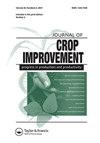Evaluation of nutritional and antinutritional compounds in a collection of Camelina sativa varieties
IF 1.5
Q3 AGRONOMY
引用次数: 2
Abstract
ABSTRACT Camelina [Camelina sativa (L.) Crantz] is an emerging oilseed crop that is attracting interest because of its high environmental adaptability and oil and protein quantity and quality. Seventeen camelina varieties of different geographical origins, sown in the same locality on two sowing dates, were compared for oil, protein, and antinutritional compounds in the meal. ANOVA showed that sowing time significantly affected the content of main fatty acids, whereas 1000-seed weight, glucosinolates (GLSs), trypsin inhibitor (TI), monounsaturated and polyunsaturated fatty acids were related to the genotype. Among the varieties analyzed, Pearl and CCE26 proved to be the best source of healthy oil, with high n-3/n-6 ratio, whereas Luna and Przybrodzka, having a lower content of GLSs and TI, were suitable for animal feed. Principal Component Analysis (PCA) allowed to group the 17 varieties into three subgroups, and the largest variation was observed among the Canadian varieties.骆驼品种中营养成分和抗营养成分的评价
Camelina[Camelina sativa(L.)Crantz]是一种新兴的油料作物,因其具有较高的环境适应性以及油脂和蛋白质的数量和质量而备受关注。在两个播种日期在同一地点播种的17个不同地理来源的山茶属品种,对膳食中的油脂、蛋白质和抗营养化合物进行了比较。方差分析表明,播种时间对主要脂肪酸含量有显著影响,而1000粒重、硫代葡萄糖苷(GLSs)、胰蛋白酶抑制剂(TI)、单不饱和脂肪酸和多不饱和脂肪酸酯与基因型有关。在所分析的品种中,Pearl和CCE26被证明是健康油脂的最佳来源,具有较高的n-3/n-6比例,而Luna和Przybrodzka具有较低的GLSs和TI含量,适合用作动物饲料。主成分分析(PCA)将17个品种分为三个亚组,其中加拿大品种的变异最大。
本文章由计算机程序翻译,如有差异,请以英文原文为准。
求助全文
约1分钟内获得全文
求助全文
来源期刊

Journal of Crop Improvement
Multiple-
CiteScore
3.30
自引率
7.70%
发文量
42
期刊介绍:
Journal of Crop Science and Biotechnology (JCSB) is a peer-reviewed international journal published four times a year. JCSB publishes novel and advanced original research articles on topics related to the production science of field crops and resource plants, including cropping systems, sustainable agriculture, environmental change, post-harvest management, biodiversity, crop improvement, and recent advances in physiology and molecular biology. Also covered are related subjects in a wide range of sciences such as the ecological and physiological aspects of crop production and genetic, breeding, and biotechnological approaches for crop improvement.
 求助内容:
求助内容: 应助结果提醒方式:
应助结果提醒方式:


